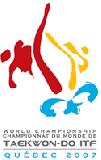Living the Taekwon-Do Way of Life in Our Training


Photo – courtesy of Mr. Dag A. Ivarsoy
- living in harmony with the Taekwon-Do philosophy
- adapting ancient philosophies to our modern life
- training to have a healthy mind in a healthy body
- having a well-balanced life
- always seeking self-improvement
- promoting respect for human rights
- working for justice and peace
- building a better world and much more.
In this message, I will continue to explore what it means to make Taekwon-Do your way of life. You will recall that in my previous message I described how living the ITF Taekwon-Do way has helped me to survive the difficult times and to have a happier and more satisfying life. We also saw that living the Taekwon-Do way of life applies to all aspects of our lives.
In the present message, we will look at the importance of our Taekwon-Do training and how learning about the Do and applying it in our training will help us to become true martial artists for the 21st Century.
I have invited Dr Janel Gauthier, Ph.D., who is a Professor of Psychology at Laval University in Quebec City (Canada), to join me for this discussion.
Dr Gauthier has been practicing ITF Taekwon-Do for almost twenty years and will soon undergo testing for the 4th degree Black Belt. In addition, he is the Chair of the ITF Ethics & Discipline Committee and one of the developers and presenters of the first workshop on Teaching the Do: Self-Control.
TTQ: Dr Gauthier, perhaps you could start by telling us how your personal and professional experience has made you aware of the value of living the Taekwon-Do way of life.
JG: I have been a practicing psychologist for the last 32 years and because of my interest in the application of behavioral psychology in health and education, I am convinced of the importance of solid moral values in achieving a happy and balanced life.
I was attracted to the practice of ITF Taekwon-Do as a martial art but also because of the strong philosophical component. This combination forms a foundation that we can build on to achieve our goal of a healthy mind in a healthy body.
My work on the development and application of codes of ethics for various professional organizations has reinforced my belief in the need for ethical guidelines. This has carried over into my work for the ITF, particularly as Chair of the ITF Committee on Ethics and Discipline and, most recently, the development of a master teaching program for the Do.
TTQ: I thought we could discuss how the Taekwon-Do way of life applies to our Taekwon-Do training by looking at certain aspects of our training and how the Taekwon-Do way of life may influence them. The aspects I would like to consider today are:
- fundamental exercises (basic movements) and patterns;
- prearranged ( step) sparring and free sparring;
- breaking;
- competition;
- overtraining.
ITF Training’s circle (composition and cliente)

JG: It is certainly worth taking the time to consider how the ITF Taekwon-Do philosophy and moral values apply to these aspects of our training. We will be able to benefit fully from the value of Taekwon-Do only if we integrate the Do into our training – and into our daily life.
TTQ: I remember how proud General Choi was of the more than three thousand fundamental exercises that he created for the ITF Taekwon-Do system. He described these movements as a scientific, rational, and natural use of the human body for effective combat techniques. The movements were synthesized into logical sequences to facilitate training.
Practicing the 24 patterns as defined by General Choi helps us to improve our level of technical skills: the quality of techniques and stances, notably the power and beauty, sense of balance, flexibility, rhythm, coordination, etc. In addition, when we realize how much there is to learn, we begin to understand the value of perseverance.
General Choi gave a name to each of the 24 patterns. Most of the patterns were named in honor of important figures in the history of Korea, people who made a contribution to their country and their society.
JG: Looking at it in the historical context, we can understand why General Choi chose these names. He was a military man and he originally developed Taekwon-Do for the Korean military. Each of the names refers to an important figure, a specific achievement or an historical event well-known to Koreans.
TTQ: General Choi wanted to express his pride in his country and its achievements, as well as his pain that Korea had been divided into two countries.
JG: Today, our ultimate purpose is not the study of the history of Korea. However, learning about the stories of these Korean heroes can help us to understand more fully what we are trying to achieve by practicing the twenty-four patterns. One of those lessons is to show respect for the land of our birth and help to make it a better place to live.
TTQ: Everyone will remember that the 24 patterns reflect the 24 hours in a day. General Choi said that the 24 patterns and 24 hours remind us that to reach our goals we need to be devoted, work hard, and not waste time. Time moves steadily on – no matter what we do – so it is important to use our time wisely and work to make the world a better place. Whether we work on the local level or on the international scene, this is how we can leave a valuable legacy.
From General Choi, I learned an oriental proverb:
When an animal dies, it leaves behind its skin.
When a human dies, he leaves behind his name (his legacy).
The desire to leave a beneficial legacy is a potent motivator that should inspire us to work hard and with conviction to make the world a better place.
I would also like to point out that the composition of the ITF patterns – including the number of patterns, the way to perform the movements, and the diagrams – has evolved since General Choi first introduced them on the international level in the early 1960s. He continued to make adjustments until he felt the patterns were complete. After the introduction of the sine wave theory, he believed he had found the right balance.
The shape of the diagram for each pattern also has a specific meaning. For example: A diagram shaped like the capital letter “I” resembles the Chinese or Korean character meaning “student” or “scholar”.
In ancient civilizations, scholars were part of the elite of society. They enjoyed the privileges of their status, but they had to earn that status. The scholars also had a greater responsibility to make a contribution to their society and their country. In addition, they were expected to demonstrate exemplary behavior at all times, just as the ITF expects its grand masters, masters, instructors, and all other black belts to set a good example for their juniors.
Another example is the Po Eun pattern. The diagram is simply a straight line: ―. Po Eun was a brave individual who proved his loyalty by refusing to leave his master for another, even though his loyalty cost him his life. The straight line of the diagram represents his unwavering loyalty.
There is a story behind the name and the shape of the diagram of each of the 24 patterns, and we can all benefit from learning more about them.
Now let’s move to the second aspect: prearranged sparring and free sparring.
JG: Could you describe how training with step sparring can be complementary to free sparring and the benefits from using both types of training?
TTQ: The program and methods of teaching ITF Taekwon-Do are based on progressive learning.
Because practicing the patterns is in effect sparring without a real opponent, General Choi introduced prearranged (step) sparring with an opponent as a method of training to prepare for free sparring. The two participants agree on the movements to be used and work together to improve their sparring. The goal is to understand the purpose of the movements, to master interaction with the opponent (stances and distances), and to develop faster reflexes, particularly an instantaneous response in self-defense.
By training with three-step sparring, the student can master the effective application of the techniques and develop his ability to judge distance, a key element for success in free sparring.
Two-step sparring introduces the spirit of sparring and gives the student the opportunity to practice attack, defense, and counter-attack techniques with combinations consisting of one hand technique and one foot technique.
The purpose of one-step sparring, used for more advanced training, is to be prepared for any kind of attack at any time with a single effective technique.
Step sparring is a very effective methods of training and can be particularly useful for older people. This is another example of how Taekwon-Do can be accessible and adjusted to the practitioner’s physical condition.
During my visits to ITF organizations around the world I have observed that many of our members do not train enough on step sparring. As a result, they may find it difficult to perform with proper techniques, distance, and timing when they practice free sparring.
It is like someone who is learning to play the piano but who doesn’t want to practice scales. After all, it is much more fun to play real music than to run your fingers up and down the keyboard repeatedly! But experience has shown that by practicing scales the student learns techniques that serve him well when, eventually, he plays more complicated pieces of music.
General Choi always stressed that step sparring must be an integral part of our training. When I was younger, I was more interested in free sparring. I wanted to progress and to do so quickly and I thought free sparring was the best way. However, as I grew older and gained experience and maturity I understood that General Choi was right. Step sparring is essential and should have an important place in everyone’s training.
JG: Yes, practicing with step sparring is an important tool that we can use to improve our free sparring, but I would add that we have here an excellent opportunity to apply the tenet of perseverance, exercising patience as we persevere in our training.
TTQ: That is very true. As Confucius said, One who is impatient in trivial matters can seldom achieve success in matters of great importance.
Free sparring is also a valuable training technique. It is good for improving physical condition and for mental conditioning. It also helps us prepare for the challenges we face in life.

I recommend the following approach to successful training with free sparring:
- train using the proper techniques,
- use your mind (your brain) to analyze each situation rapidly;
- make a quick decision about what your reaction should be and execute the technique with confidence, determination, and positive emotion from the heart.
Developing a strong mind is particularly important. Good techniques are important but having a strong mind allows you to use those techniques to best advantage.
After a free sparring match, it is really important to analyze how you performed:
- Identify your strong and weak points and those of your opponent.
- Were you able to take advantage of his weak points?
- Did you stop him from taking advantage of your weak points?
- Did you use an appropriate strategy?
- What could you have done better?
This type of honest self-evaluation, combined with the approach proposed above, will help you to apply appropriate strategies in sparring – and in life.
JG: I would add that in free sparring, as in life, it is essential to show courtesy and respect for one’s opponent. This is a basic principle of the martial arts.
Of course we always want to win a free sparring match, but winning isn’t everything. The real value of free sparring is what we learn from it. This is an opportunity to put into practice the principles of the Taekwon-Do philosophy and clearly demonstrate that we are living the Taekwon-Do way of life.
For example: I might be tempted to resort to “dirty fighting” to win a sparring match. Would that be acting with courtesy and respect toward my opponent? Would I be showing that I have self-respect? No. I would be cheating my opponent and cheating myself. Even if I did win, how could I be proud of such a victory?
I am sorry to say that in the past I have seen some students attempt to intimidate their opponents who are smaller or weaker. Some are not satisfied with winning easily and will attempt to “demolish” a weaker opponent. I have noticed that very often these same students prefer not to face a larger, stronger opponent. They will find an excuse to avoid fighting a more skilled opponent and may even pretend to be injured in order to stop a match. It is very clear that individuals who act like bullies are not applying the Taekwon-Do tenets.
Free sparring requires the application of all five of the Taekwon-Do tenets:
- The rules require opponents to show courtesy and respect to each other;
- The opponents show integrity by not indulging in “dirty fighting” tactics;
- Perseverance will help the participants to train effectively and not give up;
- Self-control is essential in Taekwon-Do sparring, step and free. Each movement must be purposeful and controlled. Emotions must be kept in check;
- Cultivating an indomitable spirit helps the participants to be motivated to train well and do their best in sparring matches. An indomitable spirit means not becoming discouraged and quitting because you are not winning.
TTQ: Indeed, living the Taekwon-Do way of life means applying the Taekwon-Do tenets in sparring… and in life.
At this point I would like to mention the need for safety in free sparring. By using the appropriate equipment, following the rules, and fighting with respect we can avoid unnecessary injuries.
Now let’s move to the next aspect of training: breaking.


JG: People who do not practice a martial art are usually very impressed by breaking. They think it is amazing, but at the same time they wonder why anyone would want to learn to break boards!
TTQ: There are good reasons why breaking is a part of Taekwon-Do training, and the purpose is certainly not just to impress people!
Breaking is a visible demonstration of good training. You cannot be successful at breaking if you have not trained well, mastered the techniques to produce maximum power, and developed your mental strength.
Breaking teaches the student the importance of cultivating perseverance, self-control, and an indomitable spirit.
JG: I would add that a student’s first success at breaking is an important step in his progress in Taekwon-Do. Mastering the breaking techniques gives an enormous boost to a student’s self-confidence.
Many students start out believing that it will be impossible for them to learn breaking, but with proper training and preparation they can do it. And being successful teaches a valuable lesson: By training well and persevering you can achieve your goals.
The student who applies this lesson in his life as well as in Taekwon-Do training will be more motivated to continue to progress and to work toward the goal of a happier, more balanced life.
TTQ: Another aspect of training is participation in competitions.
I encourage students to participate in competitions because it is good preparation for life. Preparing properly for a competition requires that the participant set goals and make plans to reach those goals. This is also how we can achieve success in life, at school and at work.
As in free sparring, participants in ITF Taekwon-Do competitions must demonstrate all five ITF Taekwon-Do tenets: courtesy, integrity, perseverance, self-control, and indomitable spirit. We should also mention the broader purpose of our competitions, which is to improve the overall quality of Taekwon-Do practiced in the ITF.
Preparing for a competition is hard work, and participating in a competition can be stressful. It is not like sparring with other students at your Taekwon-Do school. There is more pressure to perform and more pressure to win.
Of course we all want to win. But we mustn’t forget that every time one competitor wins, another competitor loses. Yes, it is important to learn to be a “good” winner, but it is equally important to learn to be a “good” loser.
A “good” winner is humble in victory and shows respect for his opponent. He realizes that each match gives him the opportunity to learn something about himself – his weaknesses and strengths – and his use of Taekwon-Do techniques. He is grateful to his opponent for participating in this learning process.
A “good” loser is humble in defeat and shows respect for the umpire’s decision and for his opponent. He too uses the opportunity to identify his weaknesses and strengths and how he can improve his techniques. Like the “good” winner, the “good” loser is grateful to his opponent for participating in this learning process.
As we can see, although one is a winner and one is a loser, the outcome for each of the opponents is a better knowledge of his strengths and weaknesses. They will both be motivated to continue their training.
JG: We can see that humility and respect for others must define the moral character of all competitors.
TTQ: Actually, those who win all the time, or most of the time, are more at risk of losing their self-confidence when they experience a string of defeats, whereas those who view their defeats as an opportunity to learn will become more resilient. When faced with failure or defeat in patterns, free sparring, breaking or other obstacles in their lives, resilient people will bounce back more effectively and efficiently than others. They see challenges instead of obstacles, and that helps them to keep a positive attitude and motivates them to work even harder.
Indeed, when examining the value of competing we must consider the mental, moral, and social aspects in addition to physical condition and the performance itself.In training, we frequently compare our performance to our own past performance, trying to do better. But by participating in competitions we have the opportunity to measure our performance in comparison to others.
To make competition a valuable experience, it is essential that we learn how to analyze our performance and determine how we can improve. This analysis must be carried out in a spirit of humility and for the purpose of self-improvement, not in a spirit of self-promotion or arrogance.
JG: As you mentioned, it is essential to understand that there is much more to competition than just performance. To benefit fully from participating in a competition, students should use it as an opportunity for self-examination and self-evaluation as well as an opportunity to apply the tenets of Taekwon-Do.
Whether you win or lose, there are valuable lessons to be learned from participating in competitions.
TTQ: I am pleased to say that in the past couple of years I have noticed that there is a very good spirit among the participants in our ITF competitions.
We have made changes to improve the quality of ITF competitions, particularly the rules and the work of the umpires. When competitors and their coaches respect the rules and accept the decisions of the umpires, the result is better quality competitions.
Now I see competitors who fight each other but are still able to enjoy fellowship together. This is living the Taekwon-Do way of life.
JG: I certainly agree that the psychological aspect is as important as the actual combat. It is important to learn how to lose and how to win.
Imagine that you are a young person who excels in competition. Perhaps you win almost all the time. Eventually you come to see yourself as a successful person simply because you are a winning competitor. However, the process of aging will catch up with you (as it does for everyone) and eventually you will no longer be able to win all the time. Where will your sense of self-worth and your self-confidence come from then?
On the other hand, if you make it your goal to become a good person with a balanced life, if you work hard to apply the tenets of Taekwon-Do, if you strive to reach what General Choi called “the perfection of moral behavior”, you will have the inner strength and the ability to believe in yourself, no matter whether you win or lose in competition. That is why Taekwon-Do is for life.
TTQ: Striving to reach “the perfection of moral behavior” is certainly a noble goal, but it can seem rather overwhelming. As I have said before, we have to take it one step at a time.
Finally, I would like to talk about the dangers of over-training.
We who practice ITF Taekwon-Do have a passion for our martial art. This passion is a wonderful thing: It enables us to make progress in our training by doing something that we love to do. But we must be aware of the danger that this passion could push us to go beyond what is reasonable in training.
There is a misconception that training must be “hard” or even painful to be effective. But successful training is not measured by how many times you have repeated a certain movement or sequence. In fact, by setting unrealistically high goals for your training, you risk injury and discouragement.
It is important to have a realistic plan for your training, one that is adapted to your physical condition and your training goals. Certainly you should push yourself to do your best, but make sure your goals are realistic.
JG: I would add that if training results in unnecessary pain and injuries, it is not in harmony with Taekwon-Do principles. In training – as in life – perseverance and indomitable spirit (which some may cite to justify “hard” training) must be moderated by self-control and integrity.
Many martial artists believe in “hard” training. According to their way of thinking, the goal of extreme training is that the mind should dominate the body and, as much as possible, the body should be trained not to feel pain under any circumstances.
We have to remember that General Choi first developed Taekwon-Do as a martial art for the members of the Korean armed forces. They were healthy young men in top physical condition, so the training was rigorous. However, Our Founder later realized that Taekwon-Do training could be beneficial for everyone, and he modified Taekwon-Do to make it accessible to all.
This shows us that Taekwon-Do training does not have to be “hard” to be effective and is another example of how ITF Taekwon-Do has continued to evolve.
TTQ: And ITF Taekwon-Do continues to evolve, because we are always working to make it better.
For example, we now put more emphasis on controlled breathing to ensure better oxygenation of the body, which has been shown to be beneficial and can result in increased life expectancy.
This would be a good time to mention the work of the ITF Technique & Instruction Committee whose mandate includes improving the quality of ITF instructors and ensuring the uniformity of teaching standards around the world. The Committee is always interested in receiving questions and suggestions from Taekwon-Do practitioners.
JG: Because Taekwon-Do is accessible to everyone, it is essential that the intensity and duration of training sessions be adapted to the physical condition and the needs of each practitioner.
The human body has been described as “the best machine in the world”, but it does have limitations. Your body will let you know when you have pushed it too far, but you have to pay attention and recognize any signs that your training regimen is not realistic.
TTQ: Here again, there is an abundance of information available in magazines, books, and on the Web. Learn as much as you can about how to train properly and seek guidance from those who have more experience.
Think about your physical safety and your physical and mental health. If you try to train too hard, you could reach a point where you lack the physical and mental energy to keep up.
Even if you do train for three hours a day, it is possible to avoid the negative effects of overtraining by making sure to give yourself time to recuperate. We lead busy lives, but it is important to get enough sleep and to include some time for relaxation. By making sure your body has an opportunity to recuperate, you will be ready and motivated to continue training. Make it your goal to have a balanced life.
JG: Overtraining can lead to physical and mental exhaustion and, eventually, to discouragement. “Hard” training is promoted as an example of supreme self-control but, if taken to extremes, it can actually become an example of a lack of self-control.
In any case, although you may train for two, three, or more hours, there are still all the other hours in the day. What you do with those hours is very important, because how you act when you are not training shows how well you apply what you have learned. That is when you demonstrate that you are truly living the Taekwon-Do way of life.
TTQ: It is also very important to set realistic training goals so that students will not become discouraged and lack motivation. It would be a pity if a student stopped practicing Taekwon-Do because he was unable to achieve success in “hard” training, when a more realistic approach to training would have allowed him to continue to improve and enjoy the benefits of ITF Taekwon-Do.
To help students stay motivated, I recommend that ITF teachers encourage them to compare their performance to their own past performances, rather than comparing themselves to others.
For example: A student could evaluate his progress every month by seeing how many pushups he can do in 30 seconds. By setting realistic goals and tracking the results, the student will see that he is making progress and will find the motivation to continue to train.
JG: To sum up our discussion, we have seen the importance of applying the Do, cultivating the tenets of Taekwon-Do, and living the Taekwon-Do way of life in all aspects of our training – and of our life.
TTQ: In conclusion, I want to emphasize that to benefit fully from Taekwon-Do, it is essential to integrate the Do into your training and your life.
As we have seen above, when General Choi was creating and developing Taekwon-Do he gave a lot of thought to the philosophical concepts underlying the physical training. He chose the names and diagrams for the patterns in his 24-pattern system to tell a story and teach the Do.
Our Founder shared with us his secrets of Taekwon-Do training and introduced speed-motions (particularly the natural, slow, continuous and connecting movements: soft motions), breathing control, and the implementation of the well-known “sine wave”. After mature reflection, he made major changes to the ITF system to achieve a balance between the hard and soft styles. This modernization made the ITF technical system coherent with his philosophy and his objective of promoting a harmonious society with peace, justice, and freedom. As I mentioned at the beginning of this message, General Choi made it possible for all ITF practitioners to adopt Taekwon-Do as their way of life and enjoy a well-balanced life.
An obvious example of his attention to detail is the name our Founder gave to this martial art and even the way he chose to write that name. We all know that “taekwon” means “hands and feet” and “Do” means “the way”. Notice that they are joined by a hyphen to form “Taekwon-Do”; this reminds us of the importance of developing the physical and the philosophical in harmony.
When you reach a certain level of knowledge and understanding of Taekwon-Do, you are able to integrate the Do seamlessly into your life. You live your life according to the values of the Do. Some would say that you eat, drink, think, and breathe Taekwon-Do. The Do truly becomes a part of you, and you become a true martial artist.
This is a worthy goal for all Taekwon-Do practitioners.
The XVIth Congress of the ITF is scheduled for June 1st of this year in Quebec City (Canada), so for my next message I am preparing a summary of what your ITF team has accomplished over the last four years.
However, because I am sure you agree that living the Taekwon-Do way of life is a very interesting and important subject, I intend to continue to explore additional aspects in future messages.
I trust you have found this message both interesting and instructive.
Master Trân Triêu Quân
ITF President



 IX World Junior Championships TKD ITF Results – 2007
IX World Junior Championships TKD ITF Results – 2007













